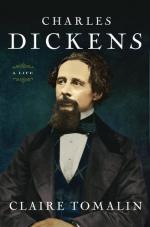|
This section contains 6,066 words (approx. 21 pages at 300 words per page) |

|
SOURCE: Steig, Michael. “Dickens, Hablôt Browne, and the Tradition of English Caricature.” Criticism 11 (1969): 219-33.
In the following essay, Steig argues that Dickens's novels provide an overall model for observing the development of literary illustration, focusing his discussion on the novels illustrated by Hablôt Browne.
Since the word “caricature” has so often been applied to Dickens' literary methods, Dickens' own attitude toward caricature is of considerable interest. Writing in 1848, Dickens called his friend and contemporary, John Leech, “the very first English caricaturist (we use the word for want of a better) who has considered beauty as being perfectly compatible with his art,” and contrasted him with earlier English graphic humorists:
If we turn back to … the works of Rowlandson or Gillray, we shall find, in spite of the great humour displayed in many of them, that they are rendered wearisome and unpleasant by a vast amount of...
|
This section contains 6,066 words (approx. 21 pages at 300 words per page) |

|


